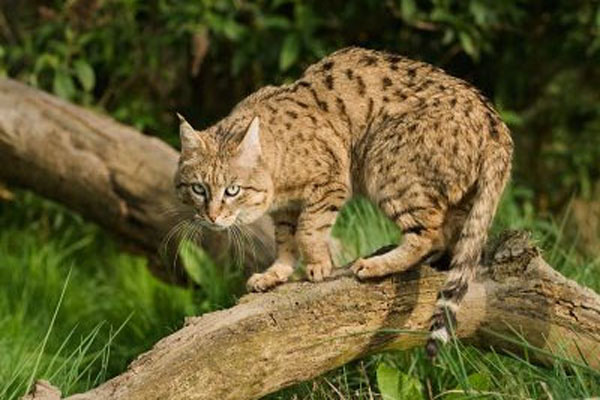CHINESE MOUNTAIN CAT
Felis bieti
Physical Description
Little is known about the Chinese Mountain Cat, a species that, in spite of its name, is endemic to northeastern Tibet. The Mountain Cat was until recently called the Desert Cat. The Cat has a thick, dual-layered coat, consisting of underfur protected by guard hairs.
In the summer, the Mountain Cat’s coat is dark brown, with paler underparts and darker hind feet. In the winter, the Cat’s fur thickens and lightens in colour, turning a pale grey yellowish brown. The Mountain Cat has a few horizontal stripes on its sides and legs, as well as a brown streak across each cheek. The Cat’s tail has a black tip and five to six dark grey bands near the tip. These markings are faint in the winter and more distinct in the summer.
The Chinese Mountain Cat has large ears and large auditory bullae. The Cat’s ears are tipped with dark brown tufts, similar to a lynx’s, but not as long. The hairs of the Mountain Cat’s ear tufts measure approximately two centimetres (0.8 inches). The Cat also has hair between the pads of its feet.
The Chinese Mountain Cat has a stocky build and relatively short legs. The Mountain Cat measures about 25 centimetres (9.8 inches) tall at the shoulder. The Cat’s head and body length measures 68 to 84 centimetres (27 to 33 inches). The Mountain Cat’s tail is fairly short, measuring about 40% of the Cat’s head and body length, or 29 to 40 centimetres (11 to 16 inches). The Cat weighs six to nine kilograms (13 to 20 pounds).
Habitat
The Chinese Mountain Cat inhabits alpine meadows, alpine scrub, and the edge of montane forests. The Cat is exclusive to the northeastern edge of the Tibetan Plateau, which falls in eastern Amdo. The Mountain Cat is most widespread in Qinghai province, but may also be found in northwestern Sichuan. The Cat’s habitat range includes the Serkhog (Datong) and Daban Mountains near Xining. The Mountain Cat occurs in these mountains at elevations from 2,800 to 4,100 metres (9,200 to 13,500 feet). Most of the Cat’s range is not protected, but the Cat’s range does overlap three reserves – Sanjiangyuan (“Source of Three Rivers”) Reserve, Tso Ngonpo (Qinghai Lake) Reserve, and Zitsa Degu (Jiuzhaigou) Reserve.
Eating Habits
The Chinese Mountain Cat preys on rodents, especially mole rats, pikas, and White-tailed Pine voles. The Cat may also eat pheasants and other birds. The Mountain Cat has been observed listening for mole rats moving underground and then digging them out.
Behaviour and Reproduction The Chinese Mountain Cat is primarily nocturnal and usually hunts in the early morning and evening. The Cat rests and gives birth in burrows. Burrows are most often constructed on south-facing slopes. Males and females live separately. The burrows of females tend to be deeper and more secure than the burrows of males, with only one entrance. The Chinese Mountain Cat’s breeding season occurs from January to March. Most litters are born in May. Litter sizes range from two to four kittens. Kittens become independent seven to eight months after birth.
Present Status
The Chinese Mountain Cat is categorized as Vulnerable in the 2003 IUCN Red List of Threatened Species and is listed under Appendix II of CITES. The Mountain Cat is currently under second class protection in China, but there is pressure on the government to increase the Cat’s protection to first class. The Mountain Cat probably inhabited a much wider range in the past than it does now. Further research about the Cat’s population and distribution is needed.
Threats to Survival
Since the 1950s, the Chinese government has carried out large-scale poisoning campaigns to reduce rodent and lagomorph populations in areas including Qinghai and Sichuan provinces. According to the IUCN, these poisoning campaigns are the most serious threat to the Chinese Mountain Cat’s survival.
Pikas, previously believed to compete with domestic livestock for graze, are one of types of rodent the poisoning campaigns have targeted. Pikas are an important food source for the Chinese Mountain Cat. Poisoning campaigns targeted at the pika have not only reduced the Chinese Mountain Cat’s prey base, they have poisoned cats that prey upon affected pikas and have resulted in environmental pollution. Zinc phosphide, one of the main chemicals used in early poisoning campaigns, has not been used since 1978 because of the toxic effect it was found to have on carnivores that preyed on pikas, but other, similarly poisonous chemicals continue to be used in ongoing campaigns. In recent years, scientists have discovered that pikas actually fulfill an important ecological role, in aerating overgrazed grassland.
Furthermore, there are several alternative methods of pest control that are as effective as poisoning but not as damaging as to the environment.
Unfortunately, many still subscribe to the wrong view that pikas are vermin and the poison campaigns have continued.
Additional threats to the survival of the Chinese Mountain Cat may include poaching and habitat degradation. Chinese Mountain Cat pelts are sold in Xining and other areas.
References
Cat Specialist Group, 2001: Felis bieti. In: IUCN 2003, 2003 IUCN Red List of Threatened Species, http://www.redlist.org. See also: http://
lynx.uio.no/catfolk/bieti-01.htm,Oct 2004.
Cat Survival Trust, The, 2002: Chinese Desert Cat, http://www.catsurvivaltrust.org/chinese.htm, Oct 2004.
He, Li, Garcia-Perea, Rosa, Li, Ming, and Wei, Fuwen, 2004: “Distribution and conservation status of the endemic Chinese mountain cat
Felis bieti,” Endangered Species Scientific Newsletter, Issue 3, http://www.cites.org.cn/newsletter/newsletter12-e.htm#9, Oct 2004.
By: Environment and Development Desk, DIIR, CTA.



comment 0